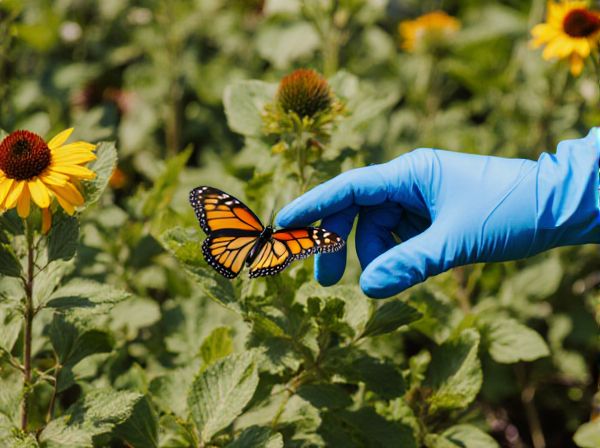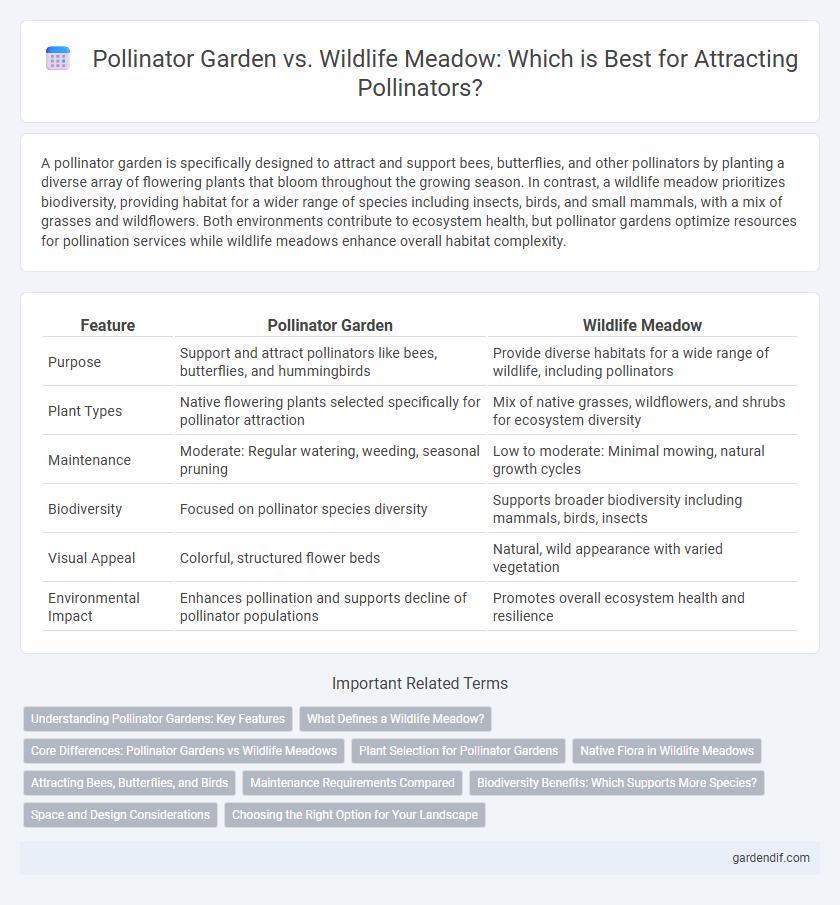
Pollinator Garden vs Wildlife Meadow Illustration
A pollinator garden is specifically designed to attract and support bees, butterflies, and other pollinators by planting a diverse array of flowering plants that bloom throughout the growing season. In contrast, a wildlife meadow prioritizes biodiversity, providing habitat for a wider range of species including insects, birds, and small mammals, with a mix of grasses and wildflowers. Both environments contribute to ecosystem health, but pollinator gardens optimize resources for pollination services while wildlife meadows enhance overall habitat complexity.
Table of Comparison
| Feature | Pollinator Garden | Wildlife Meadow |
|---|---|---|
| Purpose | Support and attract pollinators like bees, butterflies, and hummingbirds | Provide diverse habitats for a wide range of wildlife, including pollinators |
| Plant Types | Native flowering plants selected specifically for pollinator attraction | Mix of native grasses, wildflowers, and shrubs for ecosystem diversity |
| Maintenance | Moderate: Regular watering, weeding, seasonal pruning | Low to moderate: Minimal mowing, natural growth cycles |
| Biodiversity | Focused on pollinator species diversity | Supports broader biodiversity including mammals, birds, insects |
| Visual Appeal | Colorful, structured flower beds | Natural, wild appearance with varied vegetation |
| Environmental Impact | Enhances pollination and supports decline of pollinator populations | Promotes overall ecosystem health and resilience |
Understanding Pollinator Gardens: Key Features
Pollinator gardens prioritize native flowering plants that provide continuous nectar and pollen sources essential for bees, butterflies, and other pollinators. These gardens often include a diversity of plant species with staggered blooming periods, ensuring food availability throughout the growing season. Strategic planting patterns and minimal pesticide use enhance habitat quality and support pollinator health and biodiversity.
What Defines a Wildlife Meadow?
A wildlife meadow is defined by its diverse native wildflower species and grasses that create a habitat supporting a wide range of insects, birds, and mammals. Unlike a pollinator garden, which focuses primarily on attracting bees, butterflies, and other pollinators, wildlife meadows prioritize maintaining ecological balance through varied plant structure and seasonal growth patterns. This naturalistic approach enhances biodiversity and soil health, providing essential resources for multiple wildlife species throughout the year.
Core Differences: Pollinator Gardens vs Wildlife Meadows
Pollinator gardens specifically cultivate a diverse array of nectar-rich flowers and host plants to attract and sustain bees, butterflies, and other pollinating insects, prioritizing floral diversity and bloom succession. Wildlife meadows encompass a broader habitat, integrating grasses, wildflowers, and native shrubs to support a wider range of fauna including birds, small mammals, and insects by providing food, shelter, and breeding grounds. The core difference lies in pollinator gardens targeting pollinator-focused plant species for enhanced pollination services, while wildlife meadows aim to create multi-functional ecosystems supporting diverse wildlife communities.
Plant Selection for Pollinator Gardens
Pollinator gardens prioritize native flowering plants with staggered bloom times to provide continuous nectar and pollen sources for bees, butterflies, and other pollinators. Typical selections include milkweed, coneflowers, and goldenrod, which offer diverse floral resources and support specific pollinator species. In contrast, wildlife meadows feature a broader plant mix, incorporating grasses and shrubs to support various wildlife beyond pollinators.
Native Flora in Wildlife Meadows
Wildlife meadows dominated by native flora provide essential habitats that support a diverse range of pollinators, including bees, butterflies, and hoverflies, by offering continuous bloom periods and varied plant structures. Unlike pollinator gardens, which often feature a curated selection of species, wildlife meadows replicate natural ecosystems, promoting ecological resilience and sustaining native biodiversity. The preservation and restoration of native plant communities in wildlife meadows enhance ecosystem services, such as pollination and pest control, benefiting both agriculture and wild habitats.
Attracting Bees, Butterflies, and Birds
Pollinator gardens feature diverse, nectar-rich flowering plants that attract bees, butterflies, and birds by providing essential food sources and shelter. Wildlife meadows offer extensive, native wildflower habitats that support a broader range of pollinators through seasonal blooms and varied plant structures. Both garden types enhance biodiversity but pollinator gardens often deliver targeted attractants, while wildlife meadows promote larger ecosystems and habitat connectivity.
Maintenance Requirements Compared
Pollinator gardens demand regular maintenance such as watering, pruning, and weeding to ensure optimal blooming and habitat quality for bees, butterflies, and other pollinators. In contrast, wildlife meadows require minimal upkeep once established, relying on natural growth cycles with occasional mowing or controlled burns to manage invasive species and promote native plant diversity. The long-term maintenance costs and labor are generally lower for wildlife meadows, making them a sustainable option for supporting pollinator populations.
Biodiversity Benefits: Which Supports More Species?
A pollinator garden is designed to attract and support specific pollinating species such as bees, butterflies, and hummingbirds by providing tailored nectar and pollen sources, which enhances pollinator biodiversity. In contrast, a wildlife meadow supports broader biodiversity by offering a diverse habitat that accommodates a wider range of species including insects, small mammals, birds, and native plants. Wildlife meadows typically support more overall species diversity due to their structural variety and native plant richness, creating a more complex ecosystem compared to the specialized focus of pollinator gardens.
Space and Design Considerations
Pollinator gardens typically require smaller, well-managed spaces with a focus on planting diverse native flowering species that bloom sequentially to provide continuous nectar and pollen sources. In contrast, wildlife meadows demand larger areas designed for naturalistic growth, combining grasses and wildflowers to create habitats supporting a broader range of fauna beyond pollinators, including birds and small mammals. Strategic spatial planning in pollinator gardens emphasizes accessibility and visual appeal, while wildlife meadows prioritize ecological complexity and habitat diversity.
Choosing the Right Option for Your Landscape
Pollinator gardens concentrate on planting a variety of nectar-rich flowers to support bees, butterflies, and other pollinators, creating targeted habitats for these essential insects. Wildlife meadows offer a broader ecological habitat with native grasses and wildflowers that support diverse fauna, including pollinators, birds, and small mammals, enhancing overall biodiversity. Selecting between a pollinator garden and a wildlife meadow depends on your landscape size, maintenance capacity, and conservation goals, with pollinator gardens ideal for smaller, managed spaces and wildlife meadows suited to larger areas aiming for ecological restoration.
Pollinator Garden vs Wildlife Meadow Infographic

 gardendif.com
gardendif.com